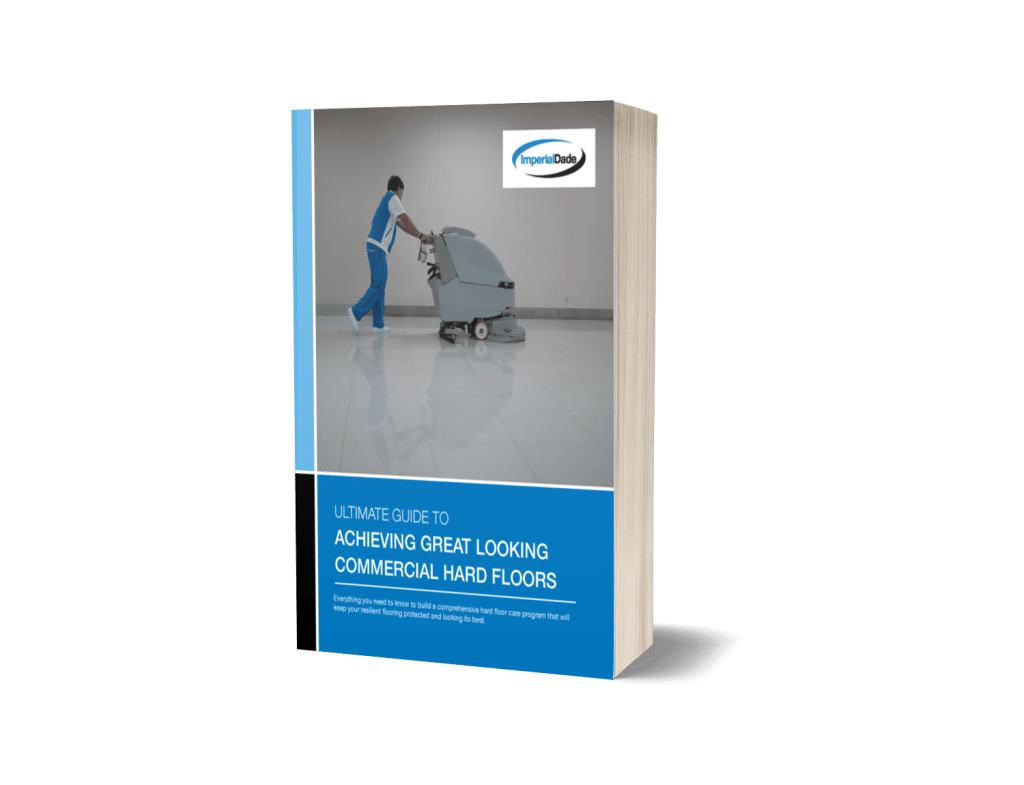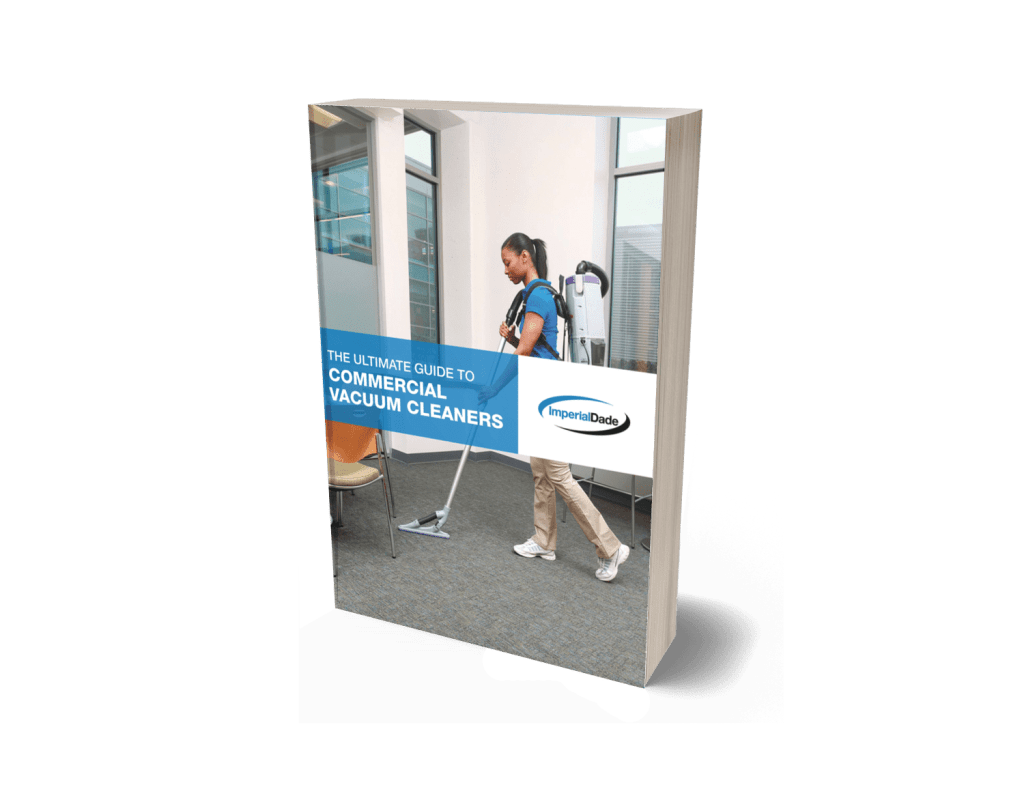VCT is one of the most flexible and popular floor types found in commercial buildings today.
Vinyl composition tile, VCT for short, is 12” square tiles that are glued to the surface of a floor. It is then coated with a finish to give the floor its desired wet-look. It is most commonly found in hallways, cafeterias, restrooms, kitchens, classrooms, and exam rooms.
Vinyl composition tile flooring is extremely popular in many commercial buildings today because it is cheap to install and durable. Like with any resilient hard flooring, VCT requires regular maintenance to keep up its appearance, prevent damage to the tiles, and extend the life of the floor.
Every effective floor care program should consist of 3 cleaning and maintenance phases: daily, periodic, and restorative floor care.
Daily floor care is cleaning and maintenance that should be done every day. Periodic floor care should be completed when the finish of your VCT flooring is experiencing a noticeable level of wear and tear. Restorative floor care is the last of the three phases, and should be performed when your VCT flooring can no longer be revived with daily and periodic care.
In this article and video, we’ll review the key components of an effective floor care program to keep your facility’s VCT flooring protected and looking great.
Proper Entryway Matting
The first component of any successful floor program is a proper entry matting system.
At every entry to your facility, a proper matting program should be installed. Entry mats are the first line of defense for your facility’s floors. They trap and contain dirt, stopping it from entering your facility.
Guests should be able to take about 8 to 10 steps on the entry matting before reaching your VCT flooring. In most cases, this will typically call for about 15 feet of matting outside and an additional 15 feet inside your building.
There are different types of matting and each serves a unique purpose.
Pro Tip: What is an effective entryway matting system? An effective entry matting system will have three different types of mats. First, scraper mats are placed outside of your entryway to scrape debris off of shoes as well as begin the removal of any liquids and moisture. Next, transition mats or scraper/wiper combination mats are placed just inside the doorway or inside vestibules. They clean shoe bottoms by removing soil as well as any remaining moisture. Finally, wiper mats remove any remaining soils from shoe bottoms so that the first steps on your floor’s surface are clean and dry.
Daily Maintenance
Daily maintenance is the first phase of floor care to keep your VCT flooring looking great.
This phase can include three different procedures: sweeping, dust mopping or vacuuming, and damp mopping or cleaning with an auto scrubber.
Sweeping
Sweeping is the first step in daily floor care.
It removes large soils and debris such as wrappers, large dirt particles and other small trash items from the area. However, if there is no noticeable debris, sweeping can be replaced with dust mopping or vacuuming.
When sweeping, ensure your staff is using the most productive broom for the area. In large open areas, like hallways or cafeterias, they should be working with the largest available broom. A large area should be swept from one end of the space to the other, creating a central garbage pile.
For congested areas, such as classrooms or offices, a smaller broom will allow staff to quickly maneuver under desks or behind objects.
To sweep stairways, begin at the top of the stairway and work down. On each step, sweep from the end of the step to the middle. Move the soil and debris downward as you progress down the stairs, ultimately collecting the debris in a dustpan on the last stair.
Dust Mopping or Vacuuming
Dust mopping and vacuuming is often considered the most important step in a floor maintenance program.
Dust mopping and vacuuming removes smaller soils and dust particles that sweeping does not remove. This is a critical step to prevent damage to the finish. Small soils and dirt can easily scratch and dull finish.
Vacuuming is the preferred method of soil removal. It can provide reduced cleaning times and increased productivity when compared to dust mopping.
Selecting the best vacuum for your facility will depend on the size of the area being cleaned and your facility’s budget.
When vacuuming, the best cleaning path will allow the user to continuously move forward without backtracking over areas that were already cleaned.
The best route will minimize the number of times the power cord has to be moved to a new outlet. Having to stop and move power cords reduces worker productivity and increases labor costs.
Pro Tip: Battery powered backpacks can increase worker productivity by as much as 230% when compared to an upright. They also reduce the risk of injury and equipment damage that is associated with power cords.
In most facilities, VCT floors should be vacuumed at least once a day but may require more or less attention depending on traffic and soil levels. Higher traffic areas, like entryways, will likely gather more soil and require more frequent vacuuming.
If your staff prefers to dust mop, the size of the mop should be based on the size of the area. Small, congested areas should be mopped with an 8-inch or 12-inch dust mop. For larger areas, it will be more efficient to use a 48-inch, 60-inch, or 72-inch dust mop.
Pro Tip: Using a microfiber mop can provide increased cleaning efficacy over traditional mops.
Check out the benefits of using microfiber mops in this article: Disposable vs Reusable Microfiber Mops: 6 Considerations for Choosing
The more soils that are removed, the more productive you can be, allowing you to get more done during a shift.
Damp Mopping or Cleaning with an Auto Scrubber
After removing all soils with sweeping and/or dust mopping and vacuuming, the floor should be cleaned.
For larger areas, it will be most effective to use an auto scrubber to clean the floors.
Damp mopping can be done in small or congested areas.
Both damp mops and auto scrubbers should be used with a neutral cleaner.
Damp Mop
If damp mopping, opt for a double bucket system, if possible. A double bucket system will keep the neutral cleaner solution in one bucket and dirty water in the other.
Damp mop in 10 ft by 10 ft areas using the “s” or “figure 8” pattern. It’s important to use the right technique so spots aren’t missed and soils are removed from the surface.
Everything you need to know about resilient hard floors including how to maintain them for best results, troubleshooting, & more!

Auto Scrubber
Auto scrubbers are large pieces of janitorial cleaning equipment with three automated systems to scrub and dry your facility’s floor in one pass.
They replace the need for traditional mop and buckets, cleaning floors faster, requiring less solution, and reducing the amount of time it takes to clean.
It is critical to use the right floor pad with your auto scrubber to avoid floor damage.
When performing daily cleaning, red or less abrasive floor pads should be used. Darker or more abrasive floor pads will remove floor finish and can damage VCT flooring.
Periodic Maintenance
Daily maintenance of your VCT floors should always be supplemented with periodic or interim maintenance procedures.
Periodic maintenance, sometimes referred to as interim maintenance, is necessary to help protect your floor from damages, restore floor shine, and reduce the need for more labor and time-intensive maintenance, like stripping and refinishing.
You need to apply your own floor finish to cover your VCT flooring to protect the floor and increase shine.
Finish can lose its shine from foot traffic and other daily wear and tear.
Scrub and Recoat
The best way to quickly restore your floor’s shine is with a scrub and recoat. Scrubbing will remove the topcoat of finish to get rid of any soils that have become embedded from daily wear and tear.
The number of times you have to scrub and recoat your floor will depend on the frequency and quality of your daily cleaning schedule and the level of traffic in each area of your facility.
For example, low-traffic areas will only need to be scrubbed and recoated two times a year. However, high-traffic areas, like entryways, will likely need to be scrubbed and recoated more frequently.
There are 6 key steps to perform a scrub and recoat.
Restorative Maintenance
Even with a complete daily and periodic maintenance routine, VCT flooring will require a full strip and finish at some point. Vinyl composition floors typically need to be stripped once a year.
Stripping is the process of removing old layers of wax and dirt, preparing the floor to be refinished, restoring the floor appearance and protecting it from future damage.
When stripping, carefully select a stripping agent that will not damage the VCT. Aggressive strippers should not be used on VCT flooring that is less than two years old because it can weaken the adhesive bond to the floor.
Pro Tip: With the right equipment, your staff can efficiently strip a floor without chemicals.
If using a chemical stripper, apply with a mop and bucket. After the stripping solution has been applied, carefully remove the solution with a wet vac or auto scrubber.
Then, the floor should be rinsed with clean water and allowed to dry before applying the new finish.
When refinishing, most manufacturers recommend there should be between 3-5 layers of finish to reduce the risk of potential damage to the tiles.
Final Thoughts
It is critical to have a complete floor care program so your VCT flooring can last as long as possible. A well maintained VCT floor can last for as long as two decades.
Keeping up with a good cleaning and maintenance schedule can help ensure you get the best return possible on your floor investment. It will also help keep building occupants satisfied with your facility’s appearance.
Installing a comprehensive floor care program with the right products and processes for your floor type can be challenging.
To help you build the best program, Imperial Dade locations have a wide range of janitorial floor cleaning equipment and commercial cleaning products to keep your floors looking their best.
Our experts are ready to help you build the best floor care program, whether you’re located in the United States, Puerto Rico, the Caribbean, or Canada.
Let one of our specialists review your current cleaning protocols and recommend the best products and procedures. Contact us today!
Everything you need to know about resilient hard floors including how to maintain them for best results, troubleshooting, & more!

Check Out These Related Articles:
- Disposable vs Reusable Microfiber Mops: 6 Considerations for Choosing
- How to Strip a Floor Without Chemicals: 5 Major Benefits
- 6 Steps to Restore Resilient Hard Floors with a Floor Buffer
- 4 Daily Procedures to Maintain Your Facility’s Resilient Hard Floors
- What is an Automatic Floor Scrubber (Types, Sizes, & Features)


